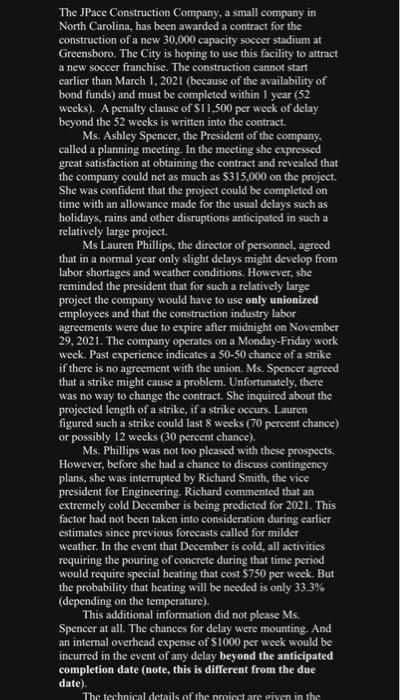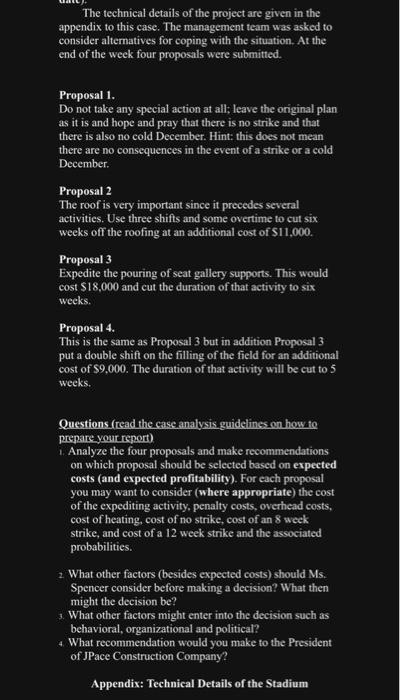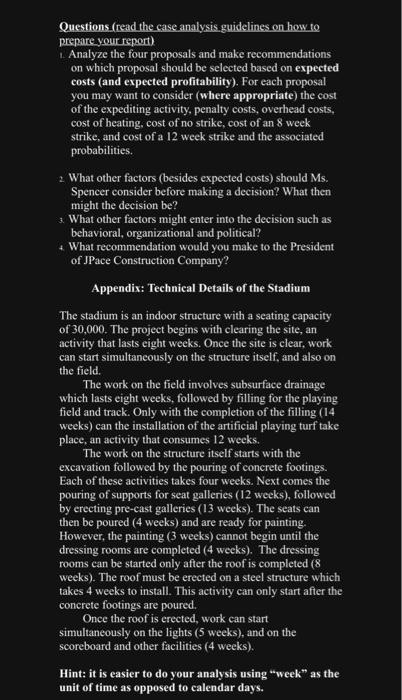Answered step by step
Verified Expert Solution
Question
1 Approved Answer
**PLEASE EXPLAIN AND CALCULATE THE EXPECTED COSTS/REVENUE FOR EACH PROPOSAL, WILL HAVE TO GIVE IT A THUMBS DOWN IF NOT** The JPace Construction Company, a
**PLEASE EXPLAIN AND CALCULATE THE EXPECTED COSTS/REVENUE FOR EACH PROPOSAL, WILL HAVE TO GIVE IT A THUMBS DOWN IF NOT** 


The JPace Construction Company, a small company in North Carolina, has been awarded a contract for the construction of a new 30,000 capacity soccer stadium at Greensboro. The City is hoping to use this facility to attract a new soccer franchise. The construction cannot start earlier than March 1, 2021 (because of the availability of bond funds) and must be completed within 1 year (52 weeks). A penalty clause of $11,500 per week of delay beyond the 52 weeks is written into the contract. Ms. Ashley Spencer, the President of the company, called a planning meeting. In the meeting she expressed great satisfaction at obtaining the contract and revealed that the company could net as much as $315,000 on the project. She was confident that the project could be completed on time with an allowance made for the usual delays such as holidays, rains and other disruptions anticipated in such a relatively large project. Ms Lauren Phillips, the director of personnel, agreed that in a normal year only slight delays might develop from labor shortages and weather conditions. However, she reminded the president that for such a relatively large project the company would have to use only unionized employees and that the construction industry labor agreements were due to expire after midnight on November 29, 2021. The company operates on a Monday-Friday work week. Past experience indicates a 50-50 chance of a strike if there is no agreement with the union. Ms. Spencer agreed that a strike might cause a problem. Unfortunately, there was no way to change the contract. She inquired about the projected length of a strike, if a strike occurs. Lauren figured such a strike could last 8 weeks (70 percent chance) or possibly 12 weeks (30 percent chance). Ms. Phillips was not too pleased with these prospects. However, before she had a chance to discuss contingency plans, she was interrupted by Richard Smith, the vice president for Engineering. Richard commented that an extremely cold December is being predicted for 2021. This factor had not been taken into consideration during earlier estimates since previous forecasts called for milder weather. In the event that December is cold, all activities requiring the pouring of concrete during that time period would require special heating that cost $750 per week. But the probability that heating will be needed is only 33.3% (depending on the temperature). This additional information did not please Ms. Spencer at all. The chances for delay were mounting. And an internal overhead of $1000 per week would be incurred in the event of any delay beyond the anticipated completion date (note, this is different from the due date). The technical details of the project are given in the The technical details of the project are given in the appendix to this case. The management team was asked to consider alternatives for coping with the situation. At the end of the week four proposals were submitted. Proposal 1. Do not take any special action at all; leave the original plan as it is and hope and pray that there is no strike and that there is also no cold December. Hint: this does not mean there are no consequences in the event of a strike or a cold December. Proposal 2 The roof is very important since it precedes several activities. Use three shifts and some overtime to cut six weeks off the roofing at an additional cost of $11,000. Proposal 3 Expedite the pouring of seat gallery supports. This would cost $18,000 and cut the duration of that activity to six weeks. Proposal 4. This is the same as Proposal 3 but in addition Proposal 3 put a double shift on the filling of the field for an additional cost of $9,000. The duration of that activity will be cut to 5 weeks. Questions (read the case analysis guidelines on how to prepare your report) 1. Analyze the four proposals and make recommendations on which proposal should be selected based on expected costs (and expected profitability). For each proposal you may want to consider (where appropriate) the cost of the expediting activity, penalty costs, overhead costs, cost of heating, cost of no strike, cost of an 8 week strike, and cost of a 12 week strike and the associated probabilities. 2. What other factors (besides expected costs) should Ms. Spencer consider before making a decision? What then might the decision be? 3. What other factors might enter into the decision such as behavioral, organizational and political? What recommendation would you make to the President of JPace Construction Company? Appendix: Technical Details of the Stadium Questions (read the case analysis guidelines on how to prepare your report) 1. Analyze the four proposals and make recommendations on which proposal should be selected based on expected costs (and expected profitability). For each proposal you may want to consider (where appropriate) the cost of the expediting activity, penalty costs, overhead costs, cost of heating, cost of no strike, cost of an 8 week strike, and cost of a 12 week strike and the associated probabilities. 2 What other factors (besides expected costs) should Ms. Spencer consider before making a decision? What then might the decision be? 3. What other factors might enter into the decision such as behavioral, organizational and political? +What recommendation would you make to the President of JPace Construction Company? Appendix: Technical Details of the Stadium The stadium is an indoor structure with a seating capacity of 30,000. The project begins with clearing the site, an activity that lasts eight weeks. Once the site is clear, work can start simultaneously on the structure itself, and also on the field. The work on the field involves subsurface drainage which lasts eight weeks, followed by filling for the playing field and track. Only with the completion of the filling (14 weeks) can the installation of the artificial playing turf take place, an activity that consumes 12 weeks. The work on the structure itself starts with the excavation followed by the pouring of concrete footings. Each of these activities takes four weeks. Next comes the pouring of supports for seat galleries (12 weeks), followed by erecting pre-cast galleries (13 weeks). The seats can then be poured (4 weeks) and are ready for painting. However, the painting (3 weeks) cannot begin until the dressing rooms are completed (4 weeks). The dressing rooms can be started only after the roof is completed (8 weeks). The roof must be erected on a steel structure which takes 4 weeks to install. This activity can only start after the concrete footings are poured. Once the roof is erected, work can start simultaneously on the lights (5 weeks), and on the scoreboard and other facilities (4 weeks). Hint: it is easier to do your analysis using "week" as the unit of time as opposed to calendar days 


Step by Step Solution
There are 3 Steps involved in it
Step: 1

Get Instant Access to Expert-Tailored Solutions
See step-by-step solutions with expert insights and AI powered tools for academic success
Step: 2

Step: 3

Ace Your Homework with AI
Get the answers you need in no time with our AI-driven, step-by-step assistance
Get Started


